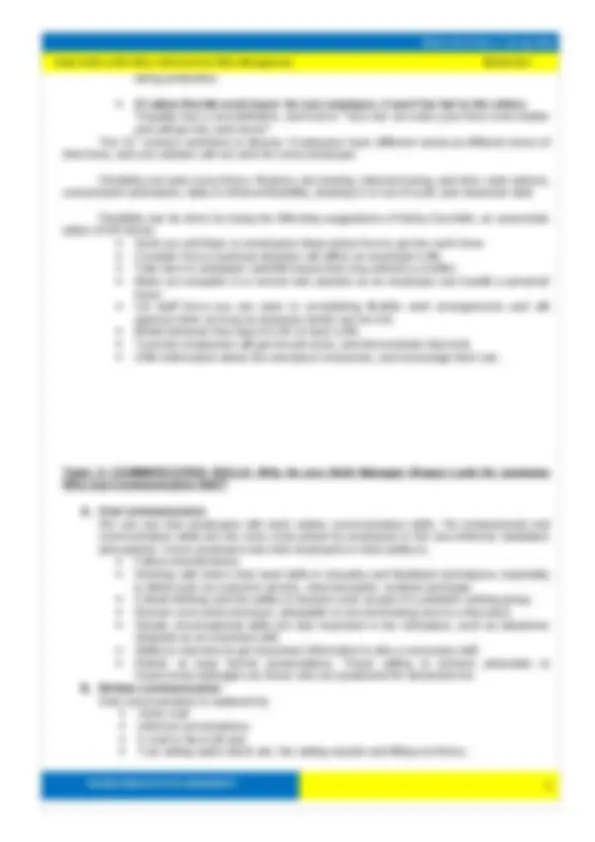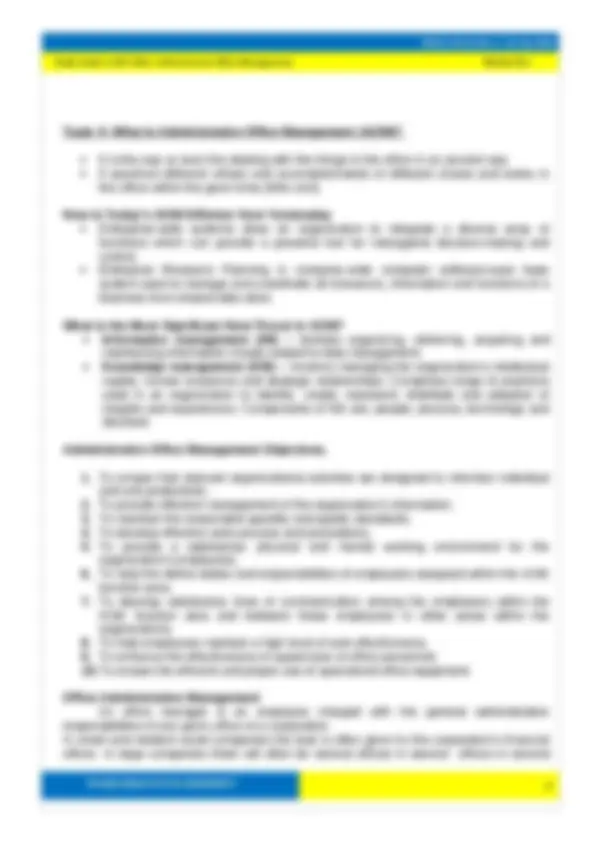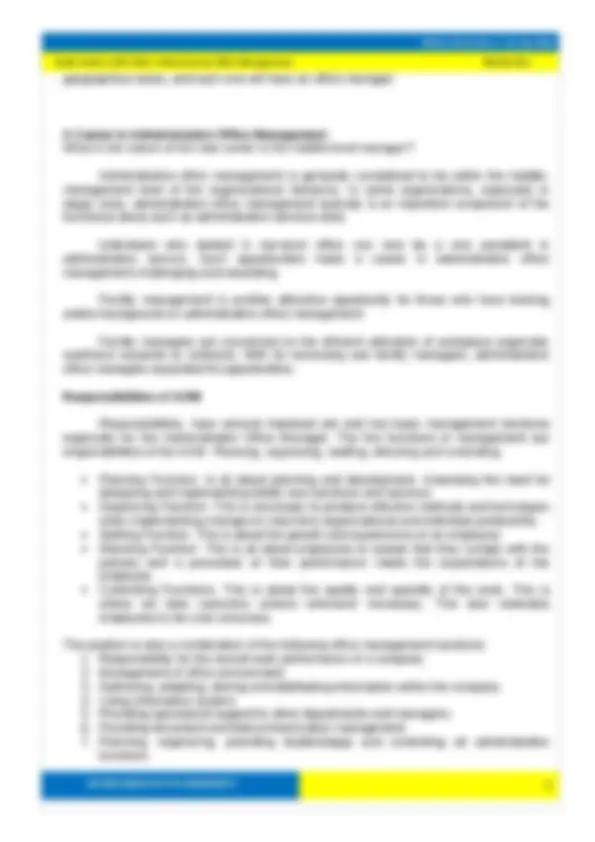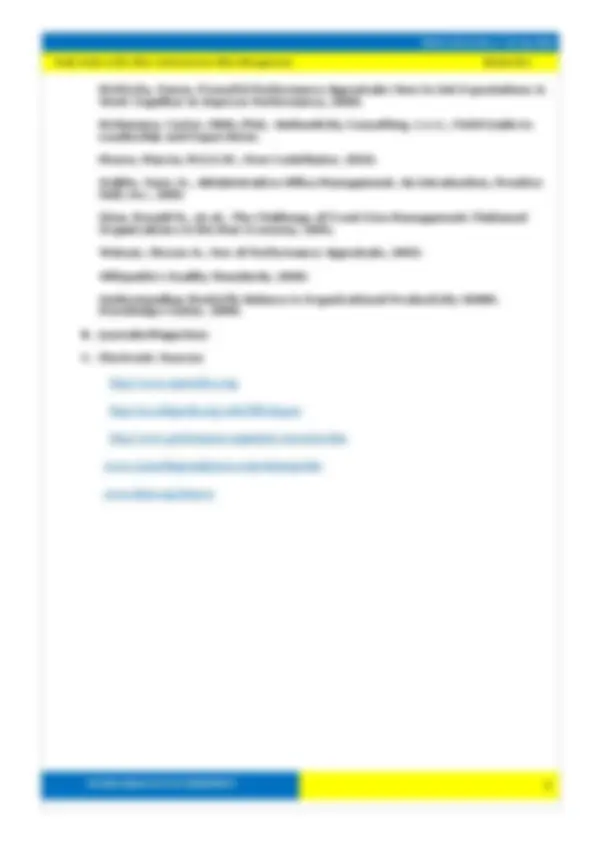







Study with the several resources on Docsity

Earn points by helping other students or get them with a premium plan


Prepare for your exams
Study with the several resources on Docsity

Earn points to download
Earn points by helping other students or get them with a premium plan
Community
Ask the community for help and clear up your study doubts
Discover the best universities in your country according to Docsity users
Free resources
Download our free guides on studying techniques, anxiety management strategies, and thesis advice from Docsity tutors
This study guide provides an overview of the administrative office management (aom) module 1, focusing on the importance of teamwork, workplace flexibility, communication skills, and the role of aom in today's businesses. It discusses the objectives of aom, the responsibilities of aom, and the qualifications required for an administrative office manager. The guide also includes learning activities and references for further study.
Typology: Study notes
1 / 9

This page cannot be seen from the preview
Don't miss anything!






PANGASINAN STATE UNIVERSITY
Study Guide in (OA 103oa Administrative Office Management) Module No.
KNOWLEDGE, SKILLS AND FUNCTIONS OF THE ADMINISTRATIVE OFFICE STAFF MODULE OVERVIEW companies are reducing their staff. One worker now does the work of many as middle management^ The new trend bin today’s businesses is to increase productivity while decreasing costs, so many is shrinking. With the continuous change in technology, employees are required to gain new skills to keep abreast of the changes. Today’s workers need communication skills: such as oral, written, and technological. the schools in particular, need input from workplace in order to develop articulation agreements with^ Today, business and industry leaders are looking for specific skills in entry-level employees. Thus, business and industry and to establish curricula designed to create a skilled workforce. teamwork, flexibility, and communication.^ According to the survey conducted, there are three main skills needed in business and these are: MODULE LEARNING OBJECTIVES At the end of this module, you should be able to: Known the importance of teamwork in the workplace; Identified the advantages and disadvantages of workplace flexibility;Understood what is administrative office management; Differentiated the AOM from today to yesterday; Known the objectives of administrative and office management; Appreciated a career in administrative and office management; and Identified the responsibilities of AOM. LEARNING CONTENTS Topic 1: TEAMWORK. Why is Teamwork Important in the Workplace? environment, people understand and believe that thinking, planning, deciding, and action are better^ Fostering teamwork is creating a work culture which values collaboration. In a teamwork when done cooperatively. People recognize, and even assimilate, the belief that none of us is good as all of us.” diverse people, ideas, backgrounds, and experiences. We have miles to go before valuing teams^ It’s hard to find work places that exemplify teamwork. Organizations are working on valuing and teamwork will be the norm. According to S.C.Gault on the Law of Countability, “teammates must be able to count each other when it counts”. “we don’t work for each other; we work with each other. You watched Pinoy Big Brother(I hope so). They always had two groups and they competed with each other. Each member of the group had to count on with each other to hold on to their goal of winning. If one member will not hold on to the goal of winning, surely the group would lose the group. To make teamwork happens, these powerful actions must occur. someone if you know his character.^ In team^ Trust^ is important. If you cannot trust anyone, you will not count on him. You trust
PANGASINAN STATE UNIVERSITY
Study Guide in (OA 103oa Administrative Office Management) Module No.
character.”(Robert Hook)^ “There^ is^ no^ substitute^ for^ character,^ you^ can^ buy^ brains,^ but^ you^ cannot^ buy would you be happier to have a good surgeon who is a bad person or a good person?^ Competence^ is necessary. If you have to go into surgery because of life-threatening illness, competence and character. (without competence one person can put the entire team to jeopardy)^ Competence matters. And if person is going to be on the same team, you want both others who might have to rely on your accomplishment such tasks for the conduct of their own job.^ It is your duty to accomplish tasks assigned to your promptly & punctually, in fairness to Don’t think about yourself alone. You are part of a great game plan. And you will win with all the rest only if you do your part. Commitment Teams succeed or fail based on commitment of team members with each other. If a good. Teams succeed or fail based on teammates commitment to one another. team player “breaks a leg” the others carry him to the top of the mountain. Many a time it is not about being the first one to be at the top of the mountain but that the whole team makes it to the top of the mountain. Never pass the buck. If something is to be done, it is your duty to do it to do it. Not to fulfill them constitutes a betrayal of trust. Do you do your job well? Even without supervision, or even when nobody is watching you? they can count on you day in and day^ Consistency.^ If you want your teammates to have confidence in you, they should know that out. Be good example. (it keeps the flow of teamwork) need for the players to add to their work load if everyone stays consistent. Your consistency builds^ Consistency in a team is a key component. It keeps the flow of teamwork and reduces the great confidence in your teammates. Cohesion. It is the ability to hold together no matter how difficult the circumstances get. Without cohesion people aren’t really a team because they are not pulling together. They are merely a group of individuals working for the same organization. that gives a teams its identity and provides a foundation on which team standson. Maxwell describe^ It is the glue which holds a team together. It is the journey to a worthwhile common goals it as “a pride in the ability of your group to function at a higher level than possible for the individual. The unit doesn’t shine because you’re good enough to be a member.
Topic 2. FLEXIBILITY. What is the Advantage and Disadvantage of Workplace Flexibility?
tardiness^ Managers should love flexibility because it reduces absenteeism, overtime, sick leave and and it reduces stress significantly. In addition, it improves performance, quality, productivity and job satisfaction; increases commitment and job engagement; and curbs turnover. rule. Managers may fear of the following:^ However, workplace flexibility often is seen as a job accommodation or an exception to the If I let one person have a flexible schedule, everyone will want one. Managers whose entire staff works flexibly say it has made them better managers because it allows goals to be set together, it allows all employees to know what they have to do and their deadlines, and it shows a sign of trust. The proof of whether it works is in the result. Someone not working on a traditional schedule is not as productive. Make sure the work is measurable, and focus on the results. You cannot have an effective team if employees are not working in the same place at the same time. Just because an employee is at his or her work station doesn’t mean that person is
PANGASINAN STATE UNIVERSITY
Study Guide in (OA 103oa Administrative Office Management) Module No.
Topic 4: What is Administrative Office Management (AOM)? It is the way or even the dealing with the things in the office in an ancient way. It practices different virtues and accomplishments of different chores and works in the office within the given time.(Wiki.com) How is Today’s AOM Different from Yesteraday Enterprise-wide systems allow an organization to integrate a diverse array of functions which can provide a powerful tool for managerial decision-making and control.Enterprise Resource Planning is company-wide computer software-ware base system used to manage and coordinate all resources, information and functions of a business from shared data store. What is the Most Significant New Thrust in AOM? Information maintaining information closely related to data management. management (IM) – Itentails organizing, retrieving, acquiring and Knowledge management (KM) – Involves managing the organization’s intellectual capital, human resources and strategic relationships. Comprises range of practices used in an organization to identify, create, represent, distribute and adoption of insights and experiences. Components of KM are; people, process, technology and structure. Administrative Office Management Objectives.
1. To ensure that relevant organizational activities are designed to minimize individual and unit productivity; 2. To provide effective management of the organization’s information; 3. To maintain the reasonable quantity and quality standards; 4. To develop effective work process and procedures; 5. To organization’s employees; provide a satisfactory physical and mental working environment for the 6. To help the define duties and responsibilities of employees assigned within the AOM function area; 7. To develop satisfactory lines of communication among the employees within the AOM organizations. function area and between these employees in other areas within the 8. To help employees maintain a high level of wok effectiveness; 9. To enhance the effectiveness of supervision of office personnel; 10. To ensure the efficient and proper use of specialized office equipment. Office Administrative Management An office manager is an employee charged with the general administrative responsibilities of any given office of a corporation. In small and medium sized companies the task is often given to the corporation’s financial officer. In large companies there will often be several offices in several offices in several
PANGASINAN STATE UNIVERSITY
Study Guide in (OA 103oa Administrative Office Management) Module No. geographical areas, and each one will have an office manager.
A Career in Administrative Office Management What is the nature of the new career in the middle-level manager? Administrative office management is generally considered to be within the middle- management level of the organizational hierarchy. In some organizations, especially in larger ones, administrative office management typically is an important component of the functional areas such as administrative services area. Individuals who started in low-level office can now be a vice president in administrative service. Such opportunities make a career in administrative office management challenging and rewarding. Facility management is another attractive opportunity for those who have training and/or background on administrative office management. workforce expands or contracts. With its increasing use facility managers, administrative^ Facility managers are concerned on the efficient utilization of workplace especially office managers expanded its opportunities. Responsibilities of AOM Responsibilities, have several important job and has basic management functions especially for the Administrative Office Manager. The five functions of management are responsibilities of the AOM. Planning, organizing, staffing, directing and controlling. Planning Function. designing and implementing totally new functions and services. Is all about planning and development. Assessing the need for Organizing Function. This is necessary to produce effective methods and techniques when implementing changes to maximize organizational and individual productivity. Staffing Function. This is about the growth and experiences of an employee. Directing Function. This is all about employees to assure that they comply with the policies employee. and a procedure of their performance meets the expectations of the Controlling Functions. This is about the quality and quantity of the work. This is where we take corrective actions whenever necessary. This also motivates employees to be cost conscious. The position is also a combination of the following office management functions:
PANGASINAN STATE UNIVERSITY
Study Guide in (OA 103oa Administrative Office Management) Module No.
Review all the lessons and prepare for a quiz after discussion.
Cite ways why AOM is not the same as before as to the:
REFERENCES Web-linked sources A. Books and E-books Blanchard, Ken, et.Al., Beginning the Journey Lead Like Jesus, Church Strengthening Ministry, Inc., 2003. Blanchard, Ken, Teambuilding Braun Consulting News, News on Personnel, Labor Relations and Benefits. Clements-Croome, Derek J., The University of Reading, The School of Construction Management and Engineering. Harvard Management Update, “ Stop Demotivating your Employees!” Vol. 11, No. 1, January 2006
PANGASINAN STATE UNIVERSITY
Study Guide in (OA 103oa Administrative Office Management) Module No. McKirchy, Karen, Powerful Performance Appraisals: How to Set Expectations & Work Together to Improve Performance, 2000. McNamara, Carter, MBA, Phd., Authenticity Consulting, L.L.C., Field Guide to Leadership and Supervision. Moore, Marcia, M.S.S.W., How Contributor, 2010. Quible, Zane, K., Administrative Office Management, An Introduction, Prentice Hall, Inc., 2001 Sims, Ronald R., et.al., The Challenge of Front-Line Management: Flattened Organizations in the New Economy, 2001. Watson, Steven A., Use of Performance Appraisals, 2003. Wikipedia’s Quality Standards, 2009. Understanding Work/Life Balance & Organizational Productivity SHRM, Knowledge Center, 2006. B. Journals/Magazines C. Electronic Sources http://www.openoffice.org http://en.wikipedia.org/wiki/360-degree http://www.performance-appraisal.com.intro.htm www.counselingemployees.com/sitemap.htm www.shrm.org/hrnews